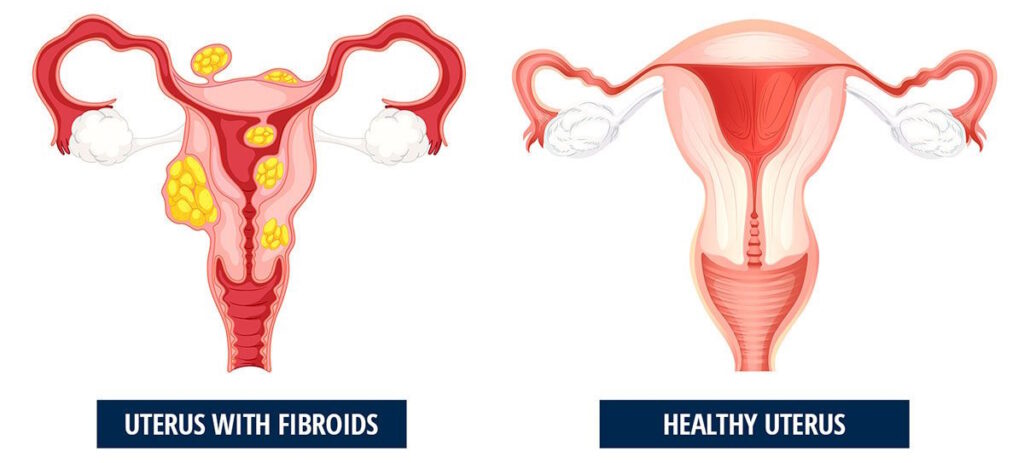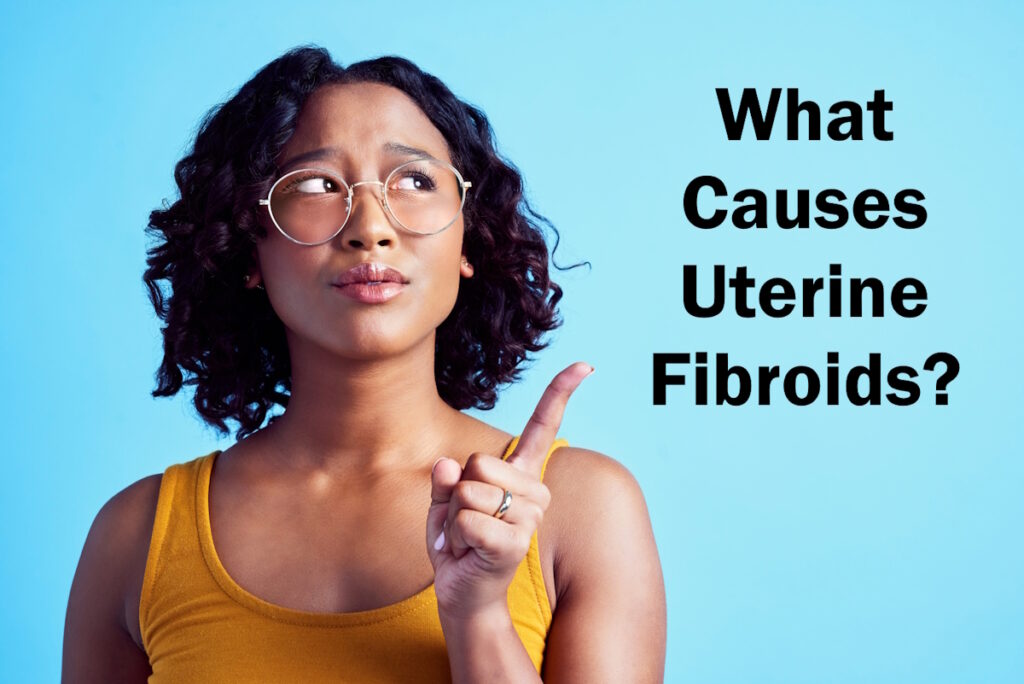When it comes to fibroids, we are used to fielding every question imaginable from women who simply want to know what they’re dealing with to those who are researching treatment options beyond fibroid surgery. But if there’s one common question a newly diagnosed patient asks, it’s this: “What caused my uterine fibroids?” And the answer is one they can’t always appreciate at first, which is, “There are several factors involved.”
Our team at Fibroid Institute Texas has dedicated our entire practice to understanding fibroids and helping the women who trust us reclaim their lives. We’d venture to say no one knows fibroids better than we do. And yet, the reality is that it’s impossible to point to one specific cause of your fibroids. The good news is that studies consistently show there are several common factors that play a role in how, when, where, and to what extent a woman will develop these noncancerous tumors.
What Are Uterine Fibroids?
Uterine fibroids are benign tumors that develop from the muscle tissue of the uterus. They can develop at different locations, differ in size, and either stay that way or grow at different rates. Many women are unaware they have fibroids and will accidentally discover them during a routine pelvic or pregnancy exam with their doctor. In other situations, fibroids can cause painful and life-altering symptoms, especially as they grow and put more pressure on the uterus and bladder. The list of fibroid symptoms can include any of the following:
- Cramps, pelvic pain, and pressure
- Painful menstrual cycles
- Heavy or inconsistent menstrual cycles
- Bloating, weight gain, or abdomen swelling
- Back or leg pain
- Urinary frequency
- Pain during sexual intercourse
- Constipation, diarrhea, and rectal discomfort

Not every woman will develop fibroids. And those who do don’t always experience symptoms. That said, researchers estimate that as many as 3 out of 4 women will develop uterine fibroids during their lifetimes. And according to the Office on Women’s Health (OWH), about 20 to 80% of them will by the time they reach age 50.
How Do You Know If You Have Uterine Fibroids?
You most likely won’t be aware that you have uterine fibroids unless you begin to have symptoms. Occasionally, fibroids are discovered by medical professionals during a standard gynecological exam. To know for absolute certain that you have fibroids, your doctor or gynecologist may conduct a few tests to find out. Below are four of the more common options:
- Physical exam – Using one hand to insert two fingers into the vagina and the other to lightly press on your abdomen, your doctor measures the size of your uterus during this examination. If you have fibroids, your uterus could feel bigger than usual or might seem to be extending into areas it shouldn’t be.
- X-rays or CT – X-rays use a form of electromagnetic radiation to “see” into the body. CT or “cat” scan takes x-rays of the body from many angles to provide a more complete image.
- Ultrasound – This form of imaging uses sound waves to take a picture of your uterus either by moving a device across your abdomen or inserting it into your vagina. An ultrasound helps your doctor determine if you have fibroids and the size of each one.
- MRI – An MRI is the best imaging technique because it provides the most information. An MRI shows fibroids that are not visible on ultrasound and the most detail in the size and position of the fibroids. It can also show other potential sources of your symptoms and give the doctor a better idea of which treatment is best.
Just because you have fibroids does not mean they need to be treated. In cases where a patient has asymptomatic fibroids, her OBGYN might recommend a “wait and see” approach. But if you start noticing changes in your menstrual cycle that are not what you’re used to, or you begin experiencing pain and symptoms like those mentioned above, you may want to consider seeking treatment. Your fibroid doctor can suggest a variety of options.
Factors that Affect Uterine Fibroids
As you go through this process, you may start wondering “Why me? What is the reason for this?” Unfortunately, it’s simply not possible to point to one specific culprit for fibroid formation and growth. There are several of them, and they impact woman in very different ways. And what makes this statement increasingly unfair for so many women is that most of these factors are completely out of one’s control.
A few factors known to cause fibroids include:
Hormones
Of all the potential causes of fibroids, the one doctors have pinpointed as perhaps the most accurate is that they are under hormonal control, particularly estrogen and progesterone. Uterine fibroids have been shown to swell and grow faster during a woman’s childbearing years when hormone levels are at their highest.

Genetics
Fibroid studies conducted over the course of the past decade or longer show a consistent link between fibroids and heredity. So, if your mother or sister had fibroids, you are predisposed. In fact, the OWH says your risk of also experiencing them is roughly three times higher.
Ethnicity
Though any woman can develop fibroids, they have a much more dramatic impact on Black women in comparison to other races. In fact, the rate of hospitalization for fibroids is three times higher for Black women than white women. They are also two to three times more likely to undergo a hysterectomy and seven times more likely to have a myomectomy. Here are a few more interesting facts about fibroids and Black women:
Stress
The connection between stress and fibroids is real. Stress is the body’s biochemical response to life challenges, and to handle stress, the brain tells our body to produce extra hormones. As a result, hormone levels rise, which stimulates fibroid growth and causes symptoms to flare up. Stress can cause fibroids that were once asymptomatic to grow at an alarming rate. Often, women report that feelings of stress and anxiety disappear after noninvasive fibroid treatment. Many even say their symptoms were less severe leading up to treatment because of how they learned to manage stress.
Age
Fibroids are more common in women between the ages of 40 and 50 since they grow throughout a woman’s lifetime as they are menstruating. As hormone levels decrease over the age of 50 and after menopause, uterine fibroids can stop growing or even shrink.
Dietary choices

Red, processed meat, high-fat dairy products, salty foods, potato chips, boxed cereal, soda, baked goods, and certain carbohydrates have a direct link to fibroid growth. Drinking alcohol also increases your risk. Conversely, fiber-rich and unprocessed foods balance hormones and prevent excess weight gain. Fruits, vegetables, and other brightly colored foods reduce inflammation, and research has confirmed that improving your Vitamin D and Vitamin A levels will reduce fibroid tumor growth and/or ease symptoms. Ways you can reduce your risk of fibroids through dietary changes and lifestyle changes include:
- Eating more fruits, especially citrus, and vegetables. This includes dried fruits.
- Get more exercise
- Drink more dairy
- Additional vitamin support (Vitmain D)
- Reduce stress levels
I Have Uterine Fibroids. What Are My Options?
If you have fibroids and aren’t experiencing any symptoms like the ones above, you and your doctor may decide to take a wait-and-see approach. If your situation changes, consider an appointment with Fibroid Institute Texas to see if you are a candidate for uterine fibroid embolization (UFE). UFE is a minimally invasive procedure that only takes about an hour and requires no incisions or hospital stay.
With UFE, the experienced fibroid specialists at Fibroid Institute insert small particles through a tiny catheter at the wrist using image-guided interventional radiology. The particles are introduced through the uterine arteries into the fibroid vessels, blocking blood flow to the fibroids. By cutting off blood flow to all fibroids, the fibroids shrink and die so that you can get back to your lifestyle and normal activities quickly.

Advantages of having your UFE procedure at Fibroid Institute Texas include the following:
- Covered by most major medical insurance
- No hospital stay
- Tiny wrist puncture, no need for vaginal access
- Short period of recovery
- Patients get direct access to their doctor’s mobile number
- Treat multiple fibroids at once
- 24/7 access to physicians during treatment
- Over 90% effective in reducing symptoms
- Referrals are not required
- All providers are fibroid experts and UFE specialists
Choose Fibroid Institute Texas. Because Experience Matters.
Our mission at Fibroid Institute is to empower and inform women about treatment choices for fibroid issues. Our Houston and Dallas fibroid centers assist thousands of women in reducing their fibroid symptoms without the need for fibroid surgery. Our board-certified interventional radiologists and specialists in fibroids are committed to assisting women in achieving their dream of becoming #FibroidFree. Dr. Suzanne Slonim and Dr. John Fischer are exceptionally skilled UFE specialists who are solely committed to treating fibroid problems.
While new technology and procedures bring about excitement and possibilities, it is important to exercise caution. Fortunately, UFE has been used for more than 20 years, and numerous studies have shown that it is safe and effective. UFE has been used to treat fibroids in thousands of women, with long-lasting positive outcomes.
At Fibroid Institute Texas, we manage all MRI and diagnostic scan orders. We oversee insurance pre-authorizations as well. Patients value that appointments for treatment are scheduled in the comfort of our state-of-the-art medical facilities. Most major medical insurance providers cover the cost of UFE. With each UFE procedure, women are empowered to achieve their full potential without being limited by fibroid symptoms.
Call for an appointment with Fibroid Institute Dallas at 214-838-6440 or with Fibroid Institute Houston at 713-903-3733 or complete the form below.
"*" indicates required fields
Fibroid Institute Texas serves the Dallas and Houston areas including Highland Park, University Park, Park Cities, Garland, Mesquite, Richardson, Dallas, Sherman, Houston, Sugar Land, Katy, Webster, Clear Lake, The Woodlands, Universal City, Spring, Kingwood, Stafford, Conroe, Texas City, Cypress, League City, Bellaire, Addison, Carrollton, Plano, Frisco, McKinney, Allen, Fort Worth, Grand Prairie, HEB, Arlington, Hutchins, Irving, Duncanville, DeSoto, Cedar Hill, Lancaster, Cockrell Hill, and more.
Prior to starting any new treatment or if you have questions regarding a medical condition, always seek the advice of your doctor or other qualified health provider. This information is not a substitute for professional medical advice.
*Patient stories are true. Names and/or photos may be changed to protect patient confidentiality.
Fibroid Institute Dallas serves the DFW area including Dallas, Duncanville, DeSoto, Cedar Hill, Lancaster, Cockrell Hill, Grand Prairie, Arlington, Hutchins, Irving, Highland Park, University Park, Park Cities, Garland, Mesquite, Richardson, Dallas, Addison, Carrollton, Plano, Allen, and all of North Texas. This information is not a substitute for professional medical advice. Prior to starting any new treatment or questions regarding a medical condition, always seek the advice of your doctor or other qualified health provider.

